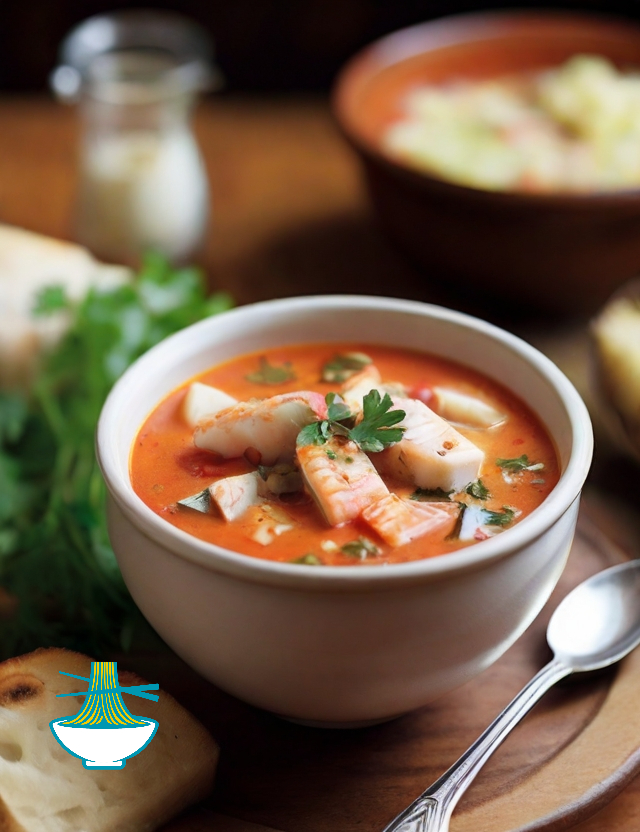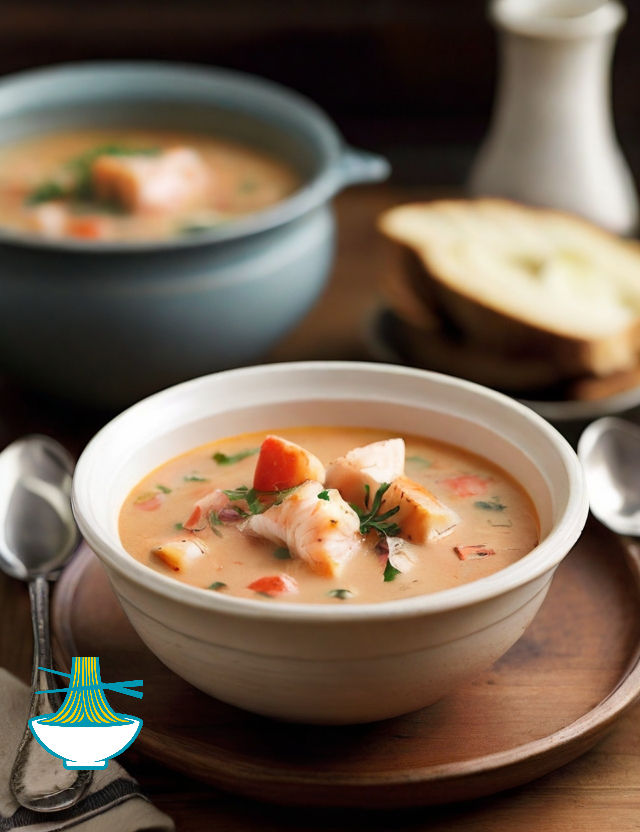Welcome to a culinary journey through the vibrant flavors of Bermuda with our authentic Fish Chowder recipe. Bursting with the essence of the island's rich maritime heritage, this hearty chowder is a celebration of the ocean's bounty and the unique blend of spices that make Bermudian cuisine truly unforgettable.
Bermuda Fish Chowder holds a special place in the hearts and palates of locals and visitors alike. It's a dish that reflects the island's diverse cultural influences, featuring a harmonious fusion of African, Portuguese, and English culinary traditions. As you embark on the creation of this savory masterpiece, you'll discover the perfect balance of sweet and savory notes, combined with a hint of heat that warms the soul.

Join us on a culinary adventure as we guide you through the steps to recreate this iconic dish in your own kitchen. Get ready to immerse yourself in the essence of Bermuda with every spoonful of this delectable Fish Chowder.
Ingredients:
- 1 lb white fish fillets (snapper, grouper, or rockfish), diced
- 1/2 lb shrimp, peeled and deveined
- 2 cups fish or seafood broth
- 1 can (14 oz) diced tomatoes
- 1 cup tomato juice
- 1 cup onion, finely chopped
- 1 cup celery, finely chopped
- 1 cup bell pepper (red or green), finely chopped
- 1 cup carrots, finely chopped
- 2 cloves garlic, minced
- 1/4 cup olive oil
- 1/4 cup all-purpose flour
- 1/4 cup tomato paste
- 1/4 cup dark rum
- 2 cups water
- 2 bay leaves
- 1 teaspoon thyme, dried
- 1 teaspoon hot sauce (adjust to taste)
- 1/2 teaspoon paprika
- Salt and pepper to taste
Instructions:
1-In a large pot, heat olive oil over medium heat. Add onions, celery, bell pepper, and carrots. Sauté until the vegetables are softened.
2-Add minced garlic and continue to sauté for another minute until fragrant.
3-Sprinkle flour over the vegetables and stir well to create a roux. Cook for 2-3 minutes, allowing the flour to lightly brown.
4-Pour in the dark rum to deglaze the pot, scraping up any bits stuck to the bottom.
5-Add fish or seafood broth, diced tomatoes, tomato juice, water, and tomato paste. Stir well to combine.
6-Add diced fish, shrimp, bay leaves, thyme, hot sauce, paprika, salt, and pepper. Bring the mixture to a simmer and let it cook for 15-20 minutes or until the fish is cooked through and the flavors meld.
7-Taste and adjust the seasoning, adding more hot sauce, salt, or pepper if needed.
8-Remove the bay leaves before serving.
9-Serve the Bermuda Fish Chowder hot, garnished with fresh parsley if desired. Optionally, accompany it with traditional Bermuda black rum swizzle for an authentic island experience.
Enjoy the warmth and richness of this hearty Bermuda Fish Chowder, a true taste of the island's culinary heritage!

Nutritional Values:
Nutritional values can vary based on specific brands and preparation methods, but here's a general estimation of the nutritional content for the listed ingredients. Keep in mind that these values are approximate and may vary based on specific brands and portion sizes:
White fish fillets (1 lb):
- Calories: 500
- Protein: 90g
- Fat: 10g
- Carbohydrates: 0g
benefits
- Rich in high-quality protein for muscle health.
- Good source of omega-3 fatty acids, beneficial for heart health.
- Provides essential vitamins and minerals, such as vitamin D and selenium.
Shrimp (1/2 lb):
- Calories: 220
- Protein: 48g
- Fat: 2g
- Carbohydrates: 2g
benefits
- Low in calories and fat, making it a light protein source.
- Contains antioxidants like astaxanthin, which may promote skin health.
- Provides essential nutrients like selenium and vitamin B12.
Fish or seafood broth (2 cups):
- Calories: 20
- Protein: 2g
- Fat: 0g
- Carbohydrates: 2g
benefits
- Rich in minerals like iodine, essential for thyroid function.
- May support joint health due to the presence of collagen.
- Low in calories and fat.
Diced tomatoes (1 can - 14 oz):
- Calories: 70
- Protein: 2g
- Fat: 0g
- Carbohydrates: 16g
benefits
- High in antioxidants, including lycopene, which may have heart health benefits.
- Good source of vitamins C and K.
- Low in calories and adds natural sweetness.
Tomato juice (1 cup):
- Calories: 40
- Protein: 2g
- Fat: 0g
- Carbohydrates: 10g
benefits
- Provides hydration and essential vitamins, especially vitamin C.
- Contains antioxidants that may support skin health.
- Low in calories and a good source of potassium.
Onion (1 cup, finely chopped):
- Calories: 50
- Protein: 1g
- Fat: 0g
- Carbohydrates: 12g
benefits
- Contains antioxidants and anti-inflammatory compounds.
- Good source of vitamin C and fiber.
- May have cardiovascular benefits.
Celery (1 cup, finely chopped):
- Calories: 15
- Protein: 1g
- Fat: 0g
- Carbohydrates: 3g
benefits
- Low in calories and a good source of fiber.
- Contains antioxidants and anti-inflammatory compounds.
- Supports hydration due to its high water content.
Bell pepper (1 cup, finely chopped):
- Calories: 30
- Protein: 1g
- Fat: 0g
- Carbohydrates: 7g
benefits
- High in vitamin C, which supports immune health.
- Contains antioxidants that may have anti-inflammatory properties.
- Good source of vitamin A and fiber.
Carrots (1 cup, finely chopped):
- Calories: 50
- Protein: 1g
- Fat: 0g
- Carbohydrates: 12g
benefits
- Rich in beta-carotene, a precursor to vitamin A, beneficial for eye health.
- Contains antioxidants that may support immune function.
- Good source of fiber.
Garlic (2 cloves, minced):
- Calories: 10
- Protein: 0g
- Fat: 0g
- Carbohydrates: 2g
benefits
- Known for its potential immune-boosting properties.
- Contains allicin, which may have antibacterial and antiviral effects.
- May have cardiovascular benefits.
Olive oil (1/4 cup):
- Calories: 480
- Protein: 0g
- Fat: 54g
- Carbohydrates: 0g
benefits
- Healthy monounsaturated fats that may benefit heart health.
- Contains antioxidants with anti-inflammatory properties.
- May have potential anti-cancer effects.
All-purpose flour (1/4 cup):
- Calories: 110
- Protein: 3g
- Fat: 0g
- Carbohydrates: 23g
benefits
- Provides energy through carbohydrates.
- Contains small amounts of protein and essential minerals.
- Should be consumed in moderation due to refined nature.
Tomato paste (1/4 cup):
- Calories: 35
- Protein: 2g
- Fat: 0g
- Carbohydrates: 8g
benefits
- Concentrated source of lycopene and antioxidants.
- Supports heart health and may have anti-inflammatory effects.
- Adds depth of flavor to dishes.
Dark rum (1/4 cup):
- Calories: 200
- Protein: 0g
- Fat: 0g
- Carbohydrates: 0g
benefits
- Contains antioxidants that may have health benefits in moderation.
- May have relaxing effects when consumed in small amounts.
- Should be consumed responsibly.
Water (2 cups):
- Calories: 0
- Protein: 0g
- Fat: 0g
- Carbohydrates: 0g
benefits
- Essential for hydration and overall bodily functions.
- Supports digestion, nutrient absorption, and temperature regulation.
- Has no calories and is crucial for overall health.
Bay leaves (2 leaves):
- Calories: 5
- Protein: 0g
- Fat: 0g
- Carbohydrates: 1g
benefits
- Contains vitamins A and C.
- May have anti-inflammatory and digestive benefits.
- Adds aromatic flavor to dishes.
Dried thyme (1 teaspoon):
- Calories: 3
- Protein: 0g
- Fat: 0g
- Carbohydrates: 1g
benefits
- Contains antioxidants with potential health benefits.
- May have antibacterial properties.
- Adds flavor and aroma to dishes.
Hot sauce (1 teaspoon):
- Calories: 0
- Protein: 0g
- Fat: 0g
- Carbohydrates: 0g
benefits
- May boost metabolism and aid in weight management.
- Contains capsaicin, which may have anti-inflammatory effects.
- Adds heat and flavor to the chowder.
Paprika (1/2 teaspoon):
- Calories: 3
- Protein: 0g
- Fat: 0g
- Carbohydrates: 0g
benefits
- Rich in antioxidants, including vitamin C.
- Contains capsaicin, which may have metabolism-boosting effects.
- Adds color and depth of flavor.
Salt and pepper (to taste): Nutritional values vary based on quantity and type.
benefits
- Provides essential minerals (sodium and potassium).
- Enhances flavor and palatability.
- Should be consumed in moderation for optimal health.
Please note that these values are rough estimates and may vary based on specific ingredients and brands used. It's always a good idea to check nutrition labels for accuracy.


Comments